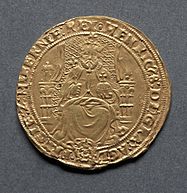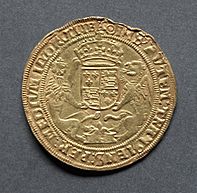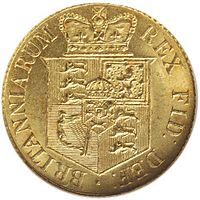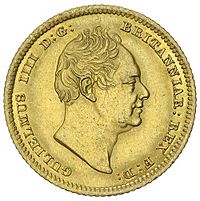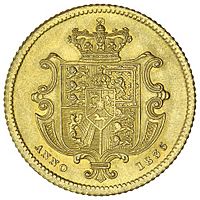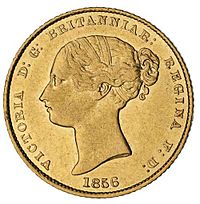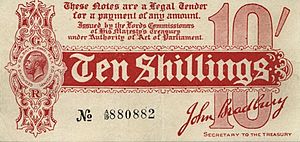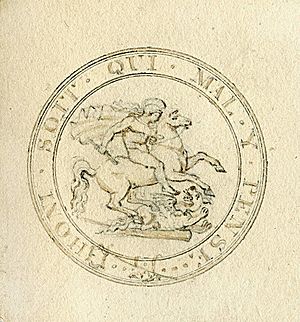Half sovereign facts for kids
| United Kingdom | |
| Value | £0.50 |
|---|---|
| Mass | 3.994 g (61.637 gr) |
| Diameter | 19 mm |
| Edge | Milled |
| Composition | .9167 gold |
| Gold | .1176 troy oz |
| Years of minting | 1817–present |
| Mint marks | I, M, P, S, SA. Found on reverse on exergue between design and date for Saint George and the Dragon coins, and under the shield for shield back coins. |
| Obverse | |
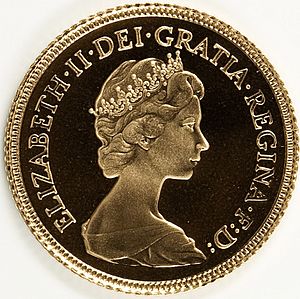 |
|
| Design | Portrait of reigning monarch (Elizabeth II obverse shown) |
| Reverse | |
 |
|
| Design | Saint George and the Dragon |
| Designer | Benedetto Pistrucci |
| Design date | 1817 (first used on half sovereign in 1893) |
The half sovereign is a British gold coin. It is worth half of a pound sterling, or 50 pence. It was first made in its current form in 1817. Since 1980, the Royal Mint has made it most years. It is sold to collectors and as a gold investment.
The half sovereign and the sovereign first appeared in 1544. This was during the time of King Henry VIII. But they stopped being made after 1604. In 1817, they were brought back as part of the Great Recoinage. Until 1926, the half sovereign was made almost every year. It was used widely as money. Besides London, it was also made at mints in Australia and South Africa. It was hard to make perfectly. People even thought about stopping it in the 1880s, even though it was popular.
Making half sovereigns stopped in 1926. Except for special coins for coronations, it wasn't made again until 1980. Since then, the Royal Mint has made it for sale. But it is not used as everyday money anymore. Most years, the coin shows the current monarch's picture. On the back, it has an image of Saint George and the dragon. This design was created by Benedetto Pistrucci. It first appeared on the sovereign in 1817. It was used on the half sovereign starting in 1893.
Contents
Early English Half Sovereigns (1544–1604)
King Henry VII (r. 1485 – 1509) helped England's economy grow. In 1489, he created the sovereign gold coin. It was worth twenty shillings. Before this, the only gold coins were angels and half angels.
Henry VII left a lot of money to his son, Henry VIII (r. 1509 – 1547). This was like £375 million today. But Henry VIII spent it all on his fancy lifestyle and wars with France. Because of this, he made coins with less and less gold. This is called "debasement."
The half sovereign was first made in 1544. It was part of Henry VIII's third set of coins. These coins had even less gold. The front of the coin shows King Henry. He is crowned and sitting on his throne. He holds an orb and a sceptre. The back has a royal shield with the symbols of France and England. A lion and a dragon hold up the shield. Henry's titles are written around the designs. The letters "HR" (for Henry the King) are at the bottom of the back.
This new coin was also made during the reign of Henry's son, Edward VI (r. 1547 – 1553). At first, it used the same designs as his father's coins. Later, it showed Edward sitting on the throne.
The half sovereign was made again under King James I (r. 1603 – 1625 in England). This started in 1603. The front shows a picture of the king. The back has a crowned shield. This shield shows the lions of England, the symbol of Scotland, the harp of Ireland, and the fleurs-de-lis of France. The coin says James is king of England, Scotland, Ireland, and France. The back also has a Latin phrase: "EXVRGAT DEVS DISSIPENTVR INIMICI." This means "Let God arise and let His enemies be scattered." The letters "I" and "R" (for James the King) are next to the shield. Only a few of these half sovereigns were made. In 1604, James I made gold coins lighter. He renamed sovereigns and half sovereigns to "unites" and "half unites." This was to celebrate him joining the two kingdoms of Great Britain. The half sovereign was later replaced by the half guinea.
British Half Sovereigns (1817 to Present)
How the Modern Half Sovereign Started
During the Napoleonic Wars, a lot of gold left Britain. People used worn guinea coins and paper money instead. After Napoleon was defeated in 1815, Parliament passed a law in 1816. This law officially put Britain on the gold standard. This meant the pound was set to a certain amount of gold. Most people in Parliament wanted a coin worth twenty shillings. This was instead of the guinea, which was worth twenty-one shillings. The new gold coins were more convenient because they were worth exactly one pound.
A special committee suggested making gold coins worth ten shillings, twenty shillings, two pounds, and five pounds. George, Prince Regent agreed to this on August 3, 1816. The twenty-shilling coin was called a sovereign. This old name was brought back. The modern sovereign coin shows St George fighting the dragon. This famous design was made by an Italian artist named Benedetto Pistrucci. It became official money in 1817, and coins were made that year. The new half sovereign had a different design on the back. It showed a shield. This was made by William Wyon.
The shield on the back showed the royal symbols of England, Scotland, and Ireland. It also included the symbols of Hanover, topped with a crown. The kings of Britain also ruled Hanover from 1714 to 1837. The first half sovereigns were made in September 1817. They were not as fancy as the larger sovereign. The half sovereign became the smallest gold coin used regularly. The first half sovereigns showed George III (r. 1760 – 1820). They were dated 1817, 1818, and 1820. No coins were dated 1819. This was because there was a plan to keep gold in the Bank of England. This plan did not work out.
Changes from 1820 to 1837
The first half sovereigns made during George IV’s reign (r. 1820 – 1830) had his picture on the front. This was made by Pistrucci. The back had a fancy crowned shield. This was designed by Johann Baptist Merlen. This first design, made in 1821, was quickly stopped. It looked too much like the sixpence coin. People could easily put gold on a sixpence and pretend it was a half sovereign.
The next time the half sovereign was made, in 1823, it had a simpler shield on the back. This was also designed by Merlen. Pistrucci's picture of George was still on the front. This version was also made in 1824 and 1825. The king did not like how Pistrucci drew him. So, Pistrucci's design was replaced in 1825. William Wyon made a new picture of the king. Pistrucci refused to copy other artists' work. He did not design any more coins after this. The back of the coin also changed. It had a fancier shield. This was made every year until 1829. The George and dragon design disappeared from the sovereign after 1825. It did not return until 1871.
Half sovereigns were not made for everyday use during William IV’s reign (r. 1830 – 1837) until 1834. But special "proof" coins were made in 1831. They were also made in 1835, 1836, and 1837. The front shows William IV's head without a crown. William Wyon engraved this. The back is like the later George IV coins. It has a crowned shield. The 1834 coin was smaller, only 17.9 mm wide. Most half sovereigns are 19.4 mm. But the weight and gold content stayed the same. It is thought the size was changed to use tools for the Maundy fourpence coin. Records show that 120,000 half sovereigns from 1834 were called back. This was because they looked too much like the old seven-shilling coins. To stop fraud, the sixpence coin started saying its value. This was because people would put gold on a sixpence to make it look like a half sovereign.
Queen Victoria's Reign (1837–1901)
Queen Victoria became queen in 1837 and ruled until 1901. The first half sovereigns of her reign were made in 1838. The first series of Victorian half sovereigns (1838 to 1886) show a young Victoria on the front. This was designed by William Wyon. The back has a shield by Merlen. The Hanoverian symbols were removed because Victoria could not rule Hanover. These coins were made in London every year from 1838 to 1885, except for 1881 and 1882. There were small changes over time. These included the size of Victoria's head and where the date was placed. Sometimes, a die number was added to track how worn the coin-making tools were.
Gold was found in Australia in 1851. So, a branch of the Royal Mint was opened there. The Sydney Mint started making half sovereigns in 1855. These coins were different from those made in London. They stated their origin at the Sydney Mint. At first, they were not legal money in Britain. As people trusted them more, Australian coins became legal money. Starting in 1871, Sydney used the same shield design as London. The Melbourne Mint opened in 1873 and made half sovereigns that year. The Perth Mint opened in 1899 and made its first half sovereigns in 1900. These mints used tools from London. They had mint marks on the back: S for Sydney, M for Melbourne, and P for Perth.
Even though the half sovereign was used more than the sovereign, some people wanted to stop making it in the 1880s. They wanted to use silver coins instead. The sovereign was used for trade around the world. But the half sovereign was mostly used in Britain. It had to be made very carefully. This meant that 45% of new half sovereigns were melted down at the mint. This made them expensive to make. The government did not make money from gold coins, unlike silver coins. So, the government did not encourage using the half sovereign. In 1884, the government tried to reduce the gold in the half sovereign. This failed. A later leader called the half sovereign "that profligate little coin." But a mint official said in 1874 that the half sovereign was very useful for giving change.
In 1887, new designs were made for silver and gold coins, including the half sovereign. These coins were called the Jubilee coinage. This was for Queen Victoria's Golden Jubilee. The front was designed by Joseph Boehm. The back had another version of the shield, with a crown on top. This was engraved by Leonard Charles Wyon. The sixpence coin of this time had no value written on it. It was the same size as the half sovereign. Many people put gold on sixpences to commit fraud. So, the new sixpence had to be stopped.
The design by Boehm showed Victoria with a crown that seemed too small. People did not like it. The Royal Mint wanted to change it quickly. A committee suggested using Pistrucci's George and Dragon design for the half sovereign. For the front, a new design by Thomas Brock was used. It showed Victoria with a veil. These coins, first made in 1893, are known as the Old Head coinage. Pistrucci's initials, BP, are not on the Old Head half sovereign. Half sovereigns with Brock's front and Pistrucci's back were made until 1901, the year the queen died.
From 1902 to 1953
The first half sovereigns during Edward VII’s reign (r. 1901 – 1910) were made in 1902. They continued until 1910. The coin shows Edward VII's head without a crown on the front. This was by George William de Saulles. The back has the George and dragon design. Coins were made in London, Melbourne, Perth, and Sydney. The back design was changed slightly in 1904. Pistrucci's initials were put back on it.
After Edward died in 1910, half sovereigns with the new king, George V (r. 1910 – 1936), were made. The front was by Bertram Mackennal. The back was Pistrucci's design. These were made from 1911 to 1915 in London. Before the First World War started in 1914, many gold sovereigns and half sovereigns were used. When war began, paper money for ten shillings and one pound was quickly made. This replaced the gold coins. The government said it was not patriotic to ask for gold money. But gold coins continued to be made at the mints in other countries, mostly for export. Half sovereigns were made in Australia until 1920. Only a few were made after 1916, all in Perth.
The 1918-P half sovereign is special. There are no records of them being made in Perth that year. They were probably made in 1919 and 1920. Then they were sent away, but we don't know where. Only a few are known today. Half sovereigns were also made in Pretoria (mint mark SA) in 1923, 1925, and 1926. The 1923-SA was only a "proof" coin, not for general use. But the Pretoria Mint made the 1925 and 1926 coins for local use. Mine owners wanted to pay workers in gold. These coins, with George V's picture, were the last half sovereigns made for everyday use.
Half sovereigns were not planned for Edward VIII (r. 1936 – 1936) in 1936. But special "pattern" coins were made for the sovereign and other larger gold coins. Half sovereigns with George VI (r. 1936 – 1952) on the front were made in 1937. This was by Humphrey Paget. The back had the St George design. These were made as part of special "proof sets" for the king's coronation. They were made again for his daughter, Elizabeth II (r. 1952 – 2022), in 1953. This was for her coronation. These coins were not for sale to the public. They were only for royal and national collections. Pistrucci's design continued to be used on the back.
Half Sovereigns for Collectors (Since 1980)
Even though the sovereign was no longer used as money, it was made as a bullion coin starting in 1957. Special "proof" coins were made from 1979. The Royal Mint saw that people wanted sovereign coins. So, they started selling them to collectors for more than their gold value. In 1980, the first Elizabeth II half sovereigns were sold to the public. They were "proof" quality. In 1982, the first half sovereigns were sold as bullion coins. Both types had Elizabeth II's second portrait on the front. This was by Arnold Machin. The back had Pistrucci's design. Proof half sovereigns with the Machin front were also made in 1983 and 1984.
From 1985 to 1997, except for 1989, proof half sovereigns were made. They had Elizabeth's third portrait, by Raphael Maklouf. Many of these were sold in sets with other gold coins. In 1989, a special design by Bernard Sindall was made. This was for the 500th birthday of the sovereign coin. Sindall used a design of Queen Elizabeth II on her throne for the front. For the back, he put a crowned shield on top of a double rose.
Elizabeth's fourth portrait, by Ian Rank-Broadley, appeared on half sovereigns from 1998 to 2015. At first, only proof coins were made. But from 2000, bullion coins were also sold. Special designs were sometimes used instead of Pistrucci's. This happened for Elizabeth II's Golden Jubilee in 2002. That design was by Timothy Noad. It showed a crowned shield in a wreath. In 2005, a more modern George and dragon design was used, also by Noad. In 2012, for Elizabeth II's Diamond Jubilee, another modern George and dragon design was used. This was by Paul Day. In 2009, Pistrucci's design was changed to look more like his original idea. This meant his initials were removed. They were put back in 2011. Sovereigns are legal money in Britain. They were made in India with the Royal Mint's permission from 2013. Half sovereigns were made there in 2014.
Starting with some proof coins in 2015, and bullion coins in 2016, Elizabeth II's fifth portrait was used. This was by Jody Clark. Proof half sovereigns dated 2016 had a different portrait of Queen Elizabeth. This was by James Butler. It was to celebrate the queen's 90th birthday. For the 200th birthday of the modern sovereign in 2017, proof half sovereigns had a design like the 1817 sovereign. Pistrucci's design was inside a Garter. Bullion coins had a small mark with "200" to show the anniversary.
In 2022, the Royal Mint made half sovereigns with a new design on the back. This was by Noad and showed the Royal Arms. It was to mark Queen Elizabeth II's Platinum Jubilee. Later that year, after Queen Elizabeth II died, the Royal Mint made special memorial coins. These included the half sovereign. They had a new Royal Arms design by Clark on the back. On the front, they had the first picture of Elizabeth's successor, Charles III (r. 2022), by Martin Jennings. Half sovereigns were made in 2023 for the coronation of Charles III. They had a crowned picture of the king by Jennings on the front and Pistrucci's design on the back.
See also
- Quarter sovereign – a smaller gold coin introduced in 2009


